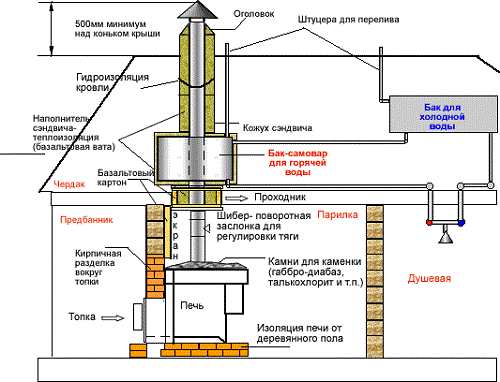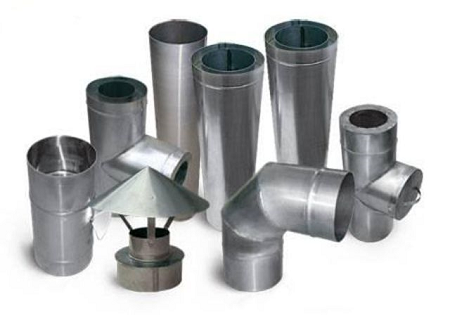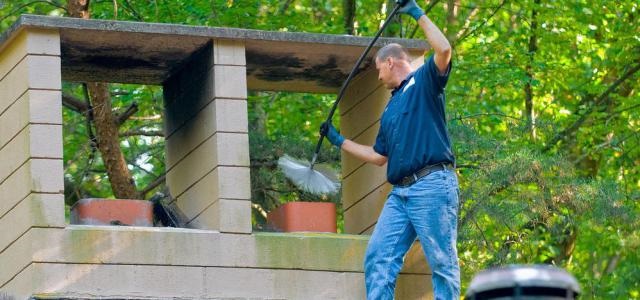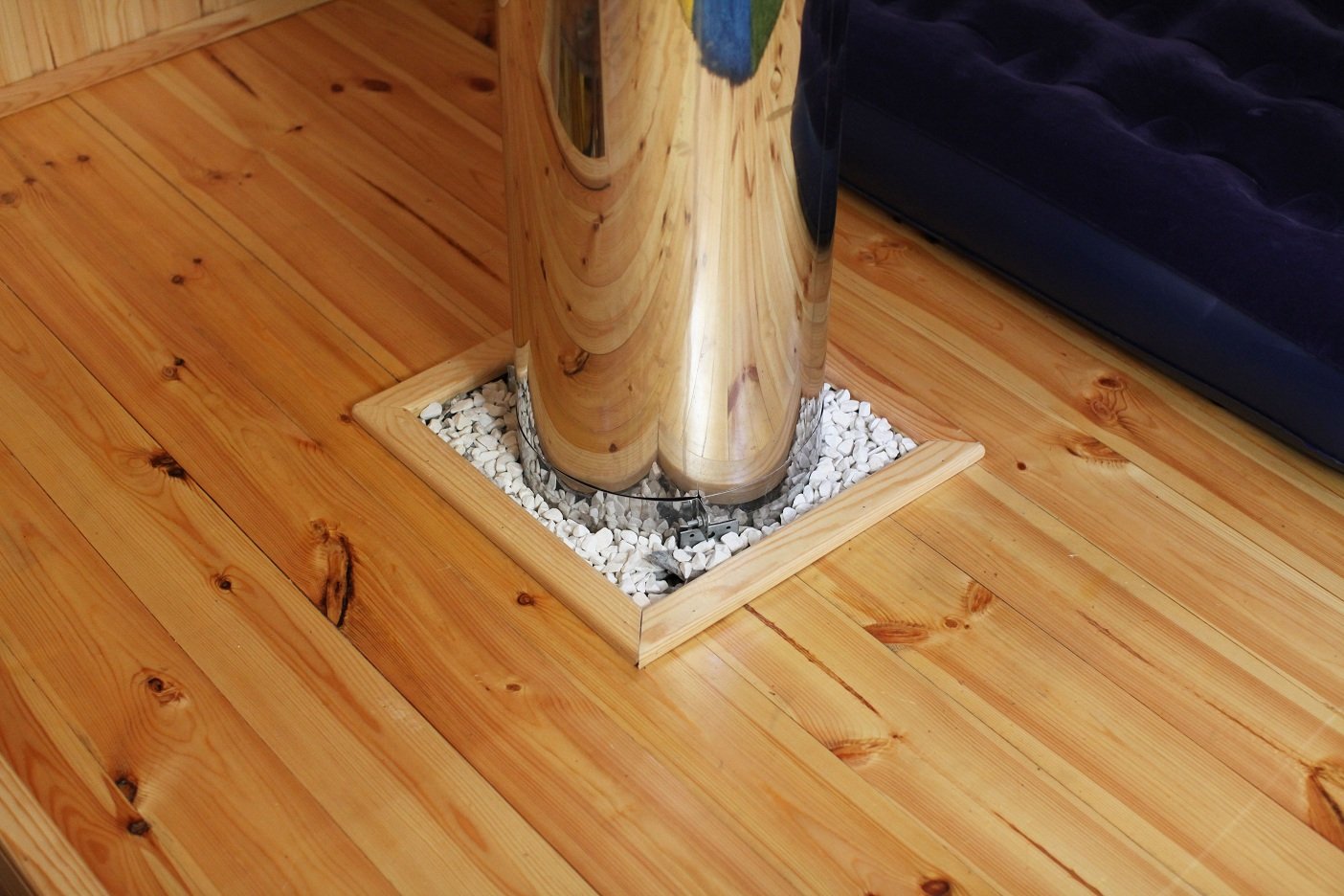Bathhouse for a Russian person is a special place. That is why a lot of time and attention is paid to its arrangement. The chimney in the bathhouse is an indispensable element, it will be discussed in this article. You will learn about the types of chimneys and their features. Read this material so as not to make common mistakes when building a bath chimney.
Content
Chimney device
Without a chimney, the operation of the bathhouse will simply be impossible, and for the chimney to function properly, it must be properly constructed. If cravings are suddenly broken, smoke will penetrate into the room, which can lead to very disastrous consequences, including carbon monoxide poisoning.

Chimneys can be internal or external. The most popular chimneys passing through the buildings, as they do not violate the general style of the bath, and also help to conserve fuel economically, because all the heat remains in the room.
Chimneys are made of various materials: ceramics, polymers, stainless steel, brick. In more detail we will talk about the last two varieties of chimneys, as they are the most common in our country.
Usually chimneys equip inside the main walls. Pipes are laid in the middle and surrounded on all sides by a kind of “box” of their bricks. To get more heat to the bathhouse, and not to go into the environment, chimneys should be placed closer to the inside of the wall. These chimneys have excellent draft.
If there is no place for the chimney inside the building, you should make it strong walls with a thickness of 35 to 65 cm, depending on the average temperatures in the region of your residence.

If there are several stoves in the bath, smoke ducts should be built for each of them. In case of non-compliance with this condition, the traction will be severely disrupted. But there is an exception: two furnaces located at the same level can have a combined chimney with a built-up dissipation device.
The basic principles of creating the right chimney:
- the best shape of the pipe is a cylinder, since local turbulence occurs in square pipes; in addition, they are much more difficult to clean;
- the diameter of the chimney channel is determined based on the number of turns of the pipe and its height;
- if there are right angles in the chimney, then the optimal length of the horizontal segments should be no more than 0.5 m or the minimum possible;
- after right angles, it is necessary to install a tee with a revision to ensure the possibility of cleaning the chimney;
- a pipe that is laid outside the building must be provided with thermal insulation;
- the design of the chimneys for the baths suggests that its vertical section should always be collected by the expanding part upstream of the formation of condensate.
A few words about installing a chimney
If you are building a small bathhouse for personal use, it will be enough to buy a ready-made chimney. This will save both time and money. For example, chimneys made of steel are a good choice. Their installation does not require much effort and very deep specialized knowledge. Finding yourself an assistant, you can easily carry out the installation yourself. In addition, on the Internet there are many schemes and drawings for installing chimneys of any complexity that can help you with the construction.
It is necessary to install the chimney so that it goes into the air about 50 cm. The main thing is not to forget about the tight junction of the roof and the chimney in order to prevent precipitation from entering the pipe.
More about materials and types of chimneys
Remember the main rule: the material of such a part of the structure as chimney chimneys must be resistant to corrosion, adapted to constant exposure to gases with high temperature (up to 500 ° C), aggressive acids, condensate.

If your bath is wooden, pay particular attention to fire safety. In such buildings, it is strictly forbidden to use pipes made of aluminum and galvanized steel.
Chimneys made of stainless steel are currently the most affordable and versatile, as they are acid- and heat-resistant, and also easy to install. For the production of components for the smoke channel, a special grade of steel with a molybdenum content is usually used, which provides products with durability and reliability.
Steel chimneys have an extensive range of notable advantages, in addition to the above. For example, they have a fairly small weight, so that they can be installed without building a special foundation.
Metal chimneys are usually divided into two groups: single-layer and insulated double-layer. Single-layer ones are most often used to create a boiler chimney inside a building, and double-layer ones are used in wood-fired boilers with a temporary operating mode (they are turned on for short periods of time, but quite often). For insulation of two-layer chimneys, mineral batuiz of basalt rocks is most often used. It is characterized by low thermal conductivity, as well as minimal formation of aggressive condensates.

Ready-made stainless steel chimneys are easy to purchase (there is a huge selection on the market at affordable prices), unlike brick chimneys, which will have to be built independently.

As mentioned above, the temperature of the combustion products reaches 500 ° C. That is why in no case can you install chimneys with an internal contour from a food stainless steel. The temperature maximum for such steels is 450 ° C. If the condition is violated, the chimney will quickly burn out, which can lead to the ignition of wooden structures.
The inner surface of the chimney made of stainless steel for the bath should be made using heat-resistant steels.

With increasing temperature, the mechanical strength of steel decreases, even the aforementioned heat-resistant ones are no exception here, so the thickness of the inner pipe should not be less than 0.8 mm.
The high combustion temperature creates a large load on the thermal insulation of the chimney. When heated to more than 250 ° C, the mass loss of the material due to its evaporation must be taken into account. Bearing this in mind, mineral wool with a density of at least 120 kg / m should be used3. Stainless chimneys must have a thermal insulation layer of at least 0.5 cm.
The average warranty period of manufacturers for stainless steel chimneys does not exceed 10 years.
In private construction, ceramic three-layer chimneys are also used. Russian manufacturers do not deal with ceramic chimney systems, so all products on the domestic market are from Europe. This is a definite plus, since all chimneys produced in the European Union are subject to strict control and certification. There are two groups of ceramic chimneys: with a self-supporting and double-circuit ceramic core and with a non-self-supporting round core. The main advantages are: resistance to rust, corrosion, mechanical stress and burnout; lack of deformation when heated; smoothness of the inner surface; the ability to prevent the formation of aggressive condensate.
The brick chimney is also very resistant to aggressive environments and high humidity. Its most important advantage is the ability to connect to absolutely any heating system, regardless of its size.
If it is necessary to avoid obstacles during the installation of the chimney, slight deviations from the vertical calculations are possible.But the brick chimney has some disadvantages. For example, only owners of large baths can afford it, since such a construction takes up a lot of space.
Brick chimney pipes need a suitable foundation. According to the rules, the construction of the pipe should be carried out in parallel with the construction of the entire building. When erecting, you need to rely on certain calculations. First, you need to calculate the required cross section of the chimney itself.
Typical size range of sections of brick chimneys:
- from 100 to 130 mm, for bath furnaces with a return of 3000 kcal / hour;
- from 130 to 250 mm, for furnaces with a heat transfer of 4,500 kcal / h (you can also take large sections in size, the main thing is to observe the proportions).
The cross-sectional area can be determined based on the power of the heating system (about 8 cm? Per 1 kW).
During the construction of such an object as a brick chimney, certain requirements for the mortar must be observed (all requirements and rules can be found in SNiP 3.03.01-87, SNiP 2.04.05-87, SNiP 2.04.05-91).
The height of the chimney at the brick chimney, placed at a distance of approximately equal to the height of the structure protruding above the roof or exceeding it, is recommended to take:
- from 50 cm and more (over an almost flat or absolutely flat roof);
- not lower than the parapet or the roof ridge;
- not lower than the line drawn down at an angle of 10 ° to the horizon.
Slightly below the connection point of the chimney pipe there must necessarily be a “pocket” with a special hatch to simplify the process of soot removal. The distance from various roofing parts made of flammable and non-flammable materials to the outer surface of the brick chimney should be approximately 13 cm, from ceramic pipes without special insulation - 25 cm.
To find and buy a chimney suitable for you, you should calculate the following parameters: boiler power, fuel combustion temperature, material, etc. Before choosing one of the options, consult with professional builders.
Chimney cleaning
In the end, a few words should be said about cleaning the chimney from soot and soot. Firstly, it must be timely, otherwise the thrust will be broken.
You can handle the chimney cleaning yourself. First you need to choose the most suitable method for you: mechanical or chemical.

If you opted for the first method, then a pole and ruff will come in handy, which will be slightly larger in size than the lumen of the chimney. The main thing here is to do everything very carefully so as not to damage the inner walls.
The chemical method is simpler and less labor intensive. It is enough to buy a special powder or liquid and add to the fuel. Under the influence of reagents, the soot itself will crumble down.
As you probably already understood, the chimney in the bathhouse is a fundamental part of the structure. Its construction should be approached with particular care and laboriousness. If you are not confident in your abilities, then it is better to invite qualified specialists. After all, with an incorrect design of the chimney, the bathhouse will not at all be suitable for use. Anyone will agree that it is better from the very beginning to build correctly, in accordance with a clear plan, rather than redo everything all over again.





Alas, no comments yet. Be the first!